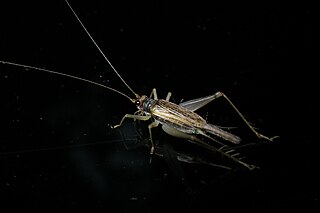
Acrididae, commonly called short-horned grasshoppers, are the predominant family of grasshoppers, comprising some 10,000 of the 11,000 species of the entire suborder Caelifera. The Acrididae are best known because all locusts are of the Acrididae. The subfamily Oedipodinae is sometimes classified as a distinct family Oedipodidae in the superfamily Acridoidea. Acrididae grasshoppers are characterized by relatively short and stout antennae, and tympana on the side of the first abdominal segment.

Bandwings, or band-winged grasshoppers, are the subfamily Oedipodinae of grasshoppers classified under the family Acrididae. They have a worldwide distribution and were originally elevated to full family status as the Oedipodidae. Many species primarily inhabit xeric weedy fields, and some are considered to be important locusts:

The Euphasmatodea, also known by its junior synonym Verophasmatodea is a suborder of the Phasmatodea, which contains the vast majority of the extant species of stick and leaf insects, excluding the Timematodea. The oldest record of Euphasmatodea is Araripephasma from the Crato Formation of Brazil, dating to the Aptian stage of the Early Cretaceous.

Gryllacrididae are a family of non-jumping insects in the suborder Ensifera occurring worldwide, known commonly as leaf-rolling crickets or raspy crickets. The family historically has been broadly defined to include what are presently several other families, such as Stenopelmatidae and Rhaphidophoridae, now considered separate. As presently defined, the family contains two subfamilies: Gryllacridinae and Hyperbaeninae. They are commonly wingless and nocturnal. In the daytime, most species rest in shelters made from folded leaves sewn with silk. Some species use silk to burrow in sand, earth or wood. Raspy crickets evolved the ability to produce silk independently from other insects, but their silk has many convergent features to silkworm silk, being made of long, repetitive proteins with an extended beta-sheet structure.

Austroicetes is a genus of grasshoppers in the subfamily Oedipodinae and family Acrididae. Members of the genus typically feed on grass and herbs.

Austroicetes frater, commonly known as the southern austroicetes, is an Australian grasshopper in the subfamily Oedipodinae and genus Austroicetes.

Chrysochraontini is a tribe of grasshoppers belonging to the subfamily Gomphocerinae.

Catantopini is a tribe in the subfamily Catantopinae, a group of grasshoppers found in Africa, Asia and Australia.

The Eyprepocnemidinae are a subfamily of Acrididae in the Orthoptera: Caelifera. Species can be found in Africa, mainland Europe and Asia.

The Clitumninae are a sub-family of stick insects in the family Phasmatidae found in Asia. The type genus Clitumnus is now considered a synonym of Ramulus.
Anabropsis is a genus of king crickets in the tribe Anabropsini. They are found tropical areas of the Americas, Africa and Asia.
Stonychophora is a genus of camel crickets in the tribe Rhaphidophorini. Species in this genus can be found from Indo-China and Malesia to New Caledonia.
Lissotrachelus is an Asian genus of crickets, typical of the tribe Lissotrachelini; species records range from southern China, Indo-China to Borneo.

Odontura is a genus of bush crickets in the subfamily Phaneropterinae and typical of the tribe Odonturini. Species can be found in Africa and Europe.
Phryganogryllacris is an Asian genus of Orthopterans, sometimes known as 'leaf-folding crickets', in the subfamily Gryllacridinae and tribe Phryganogryllacridini. Species have been recorded from: India, China, Indochina, Malesia, through to New Guinea.
Gymnobothrus is the type genus of grasshoppers in the tribe Gymnobothrini Uvarov, 1953; species can be found in Africa. Besides the synonyms listed here, several species were considered similar-to and previously placed in, the genus Chortoicetes.

Parapachymorpha is a genus of stick insects in the tribe Medaurini, erected by Carl Brunner von Wattenwyl in 1893. Species have been recorded from: China, Myanmar, Thailand, Cambodia and Vietnam.

Josef Redtenbacher was an Austrian entomologist and teacher. He specialized in the orders of Orthoptera, Phasmatodea, Mantodea (mantis) and Blattodea (cockroaches), which are classically summarized as Orthoptera, as well as in the earwigs (Dermaptera), which are not assigned to the Orthoptera, especially from Austria-Hungary and Germany.

Amusurgus is a genus of Asian "sword-tail crickets", in the subfamily Trigonidiinae and the tribe Trigonidiini, erected by Carl Brunner von Wattenwyl in 1893. Species records exist for Pakistan through to Japan, South-East Asia through to Australia.

Pachytrachis is a genus of Palaearctic bush crickets in the tribe Platycleidini, erected by Boris Uvarov in 1940. Species have been recorded from Italy, through South-eastern Europe to Turkey.














